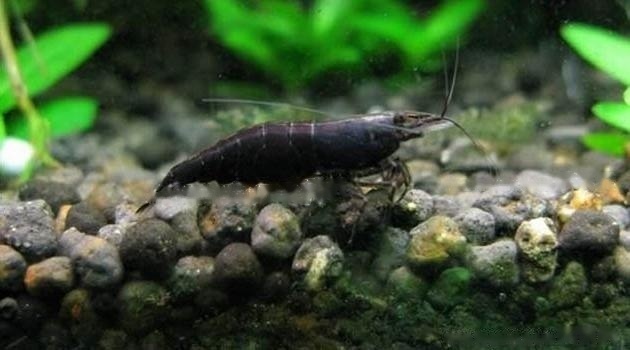Black-shell shrimp, also known as grass shrimp, rice shrimp, is a kind of key-finger shrimp that mostly lives in waters with dense aquatic plants and feeds on algae and animal and plant carcasses. Mainly distributed in freshwater ponds, streams and reservoirs. The black-shell shrimp is very gentle, will not attack other companions in the bathtub, and can accept mixed breeding. The owner does not need to feed it specially, he can eat with other aquatic animals. It is very easy to raise and has a very high ornamental value.

1. Characteristics of black-shell shrimp
The black-shell shrimp is medium in size, about 2-3 cm in length; although It is called black-shell shrimp, but not all colors are black. The color of the carapace of black-shell shrimp is more changeable, and it usually changes its color according to the changes in the living environment. The black-shell shrimp has two pairs of small claws. The inner surfaces of the two fingers of the claws are concave and slightly spoon-shaped; the ends of the spoon fingers have brush-like hairs, which are sharp tools for scraping algae, so they often scrape algae for food. The ability to clear algae is not as good as that of Yamato algae shrimp. The overall appearance is very good-looking, and it is very popular as an ornamental shrimp to raise, and its ornamental value is extremely high.
2. Habits and reproduction of black-shell shrimp
1. The incubation period of black-shell shrimp is about 20 days, and the color of shrimp eggs changes from black-green to gray-white relatively common. Juvenile black shell shrimp is about 2-3mm long, and the whole body is relatively transparent and mobile. The structure of the brain, heart, hepatopancreas and other organs of juvenile shrimp has been relatively complete, and they have strong living ability. They can crawl on the bottom, swim and feed, and complete the metamorphosis process after 2-3 molts. Water temperature control plays a decisive role in the metamorphosis of black shell shrimp. When the water temperature is 22-24°C, the whole metamorphosis process takes -6, and when the water temperature is 26°C, the metamorphosis process only takes 3-4 days.
2. Black-shelled shrimp will crossbreed with other shrimps, such as: Cherry Blossom Shrimp, Extreme Fire Shrimp, Snowball Shrimp, Golden Rice Shrimp and other ornamental shrimps, and the juvenile shrimp species produced by Viewability will be higher. In order to ensure the quality of the offspring of ornamental shrimp, please do not mix them with black-shell shrimp, and it is best to prohibit the polyculture between these types of shrimp, because the hybrid offspring are very likely to return to the common black-shell shrimp. Black shell shrimp can be mixed with other shrimp species.
3. Black-shell shrimp feeding
[Temperature control]
Black-shell shrimp is the best The living temperature is between 10-30 degrees, and the adaptability to temperature is relatively strong, and the limit survival temperature is about 5-30 degrees. Some black-shell shrimp can live in water below 5 degrees. Low temperature cannot affect the survival of black-shell shrimp, but it is not conducive to their reproduction. With the increase of water density, the maximum temperature limit that black-shell shrimp can survive will gradually decrease. Therefore, feeding is mainly based on the density of black shell shrimp to control the water temperature.
【Food Feeding】
Black-shell shrimp are vegetarian shrimp and eat more algae in the water, but according to research, black-shell shrimp will also Eating meat, such as frozen blood worms, is one of their favorite foods. The owner does not need special feeding. Black shell shrimp can be said to be a very good fish tank cleaner, he will forage for the algae in the fish tank.
【Mineral Requirements】
The breeder needs to add some minerals in addition to the plants for the scenery in the rearing box; minerals are generally selected Montmorillonite, but because of its high price, ammonia-absorbing zeolite can be used.
【Nursing Knowledge】
When feeding black-shell shrimp, it is necessary to pay attention to the water without ammonia and nitrite, which are harmful to black-shell shrimp. Fatal injury; therefore, the water used for raising black-shell shrimp should be carefully tested in advance. It is best to wait until the algae grow in the aquarium before stocking the shrimp. During the raising process, the owner should not dissolve substances such as medicines and pigments into the water. .
IV. Instructions for mixed breeding of black-shelled shrimp
Black-shelled shrimp is naturally gentle and will not attack other animals in the breeding box, and it is acceptable to mix it. Raised, but the main concern is that other animals at the wedding banquet will not attack the black shell shrimp. Black shell shrimp is suitable for polyculture with some docile small ornamental fish, but must avoid polyculture with nocturnal ornamental fish. During the growth process of black-shelled shrimp, they will molt every once in a while. The molting usually occurs at night, and the body of the shrimp will emit a fishy smell when molting. Nocturnal fish usually have a keen sense of smell and are good at drilling holes. The molting black shell shrimp is very dangerous.
![[Dog Training 5] The training method of pet dog dining etiquette](/static/img/12192/12192_1.jpg)




